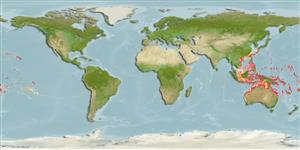Common names from other countries
>
Eupercaria/misc (Various families in series Eupercaria) >
Scaridae (Parrotfishes) > Scarinae
Etymology: Chlorurus: Greek, chloros = green + Greek oura = tail (Ref. 45335).
More on author: Bleeker.
Environment: milieu / climate zone / depth range / distribution range
экология
морской ассоциированный с рифами; пределы глубины 0 - 50 m (Ref. 90102), usually 1 - 15 m (Ref. 89972). Tropical; 31°N - 35°S, 105°E - 124°W
Pacific Ocean: Bali and the Philippines to the Line and Pitcairn islands, north to the Ryukyu Islands, south to Rottnest Island, Lord Howe Island and Rapa Island (Ref. 37816). The species complex comprise of Chlorurus gibbus in the Red Sea, Chlorurus strongylocephalus in the Indian Ocean and Chlorurus microrhinos in the west-central Pacific.
Size / Вес / Возраст
Maturity: Lm ? range ? - ? cm
Max length : 70.0 cm TL самец/пол неопределен; (Ref. 2334); common length : 49.0 cm SL самец/пол неопределен; (Ref. 37816); common length :40 cm SL (female); наибольший вес (опубликованные данные): 5.4 kg (Ref. 37816)
Краткое описание
определительные ключи | морфология | морфометрия
колючие лучи спинного плавника (общее число) : 9; членистые (мягкие) лучи спинного плавника (общее число) : 10; колючие лучи анального плавника: 3; членистые (мягкие) лучи анального плавника: 9. Juveniles below about 8 cm are black with several horizontal white streaks. Larger ones up to about 20 cm uniformly dark, greenish brown, slowly becoming blue with age. Blue streak and patch extending behind the corner of the mouth of large males often quite brilliant. Uniformly yellowish-tan individuals rare. Caudal fin lunate in large terminal males. Scale rows on cheek 3. Median predorsal scales 3-4 (Ref. 37816). Males develop large hump on head and appear blunt-headed (Ref. 48636).
Occurs in lagoon and seaward reefs. Juveniles generally solitary; large adults often school together. Feeds on benthic algae (Ref. 89972). Minimum depth reported taken from Ref. 128797.
Life cycle and mating behavior
Maturities | размножение | Spawnings | Egg(s) | Fecundities | личинки
Oviparous, distinct pairing during breeding (Ref. 205).
Parenti, P. and J.E. Randall, 2000. An annotated checklist of the species of the labroid fish families Labridae and Scaridae. Ichthyol. Bull. J.L.B. Smith Inst. Ichthyol. (68):1-97. (Ref. 35918)
Статус Красного Списка МСОП (Ref. 130435)
CITES (Ref. 128078)
Not Evaluated
Угроза для людей
Reports of ciguatera poisoning (Ref. 4690)
Использование человеком
рыболовство: коммерческий
дополнительная информация
инструменты
Специальные отчеты
Скачать в формате XML
ресурсы в Интернет
Estimates based on models
Preferred temperature (Ref.
115969): 24.8 - 29.3, mean 28.4 (based on 1923 cells).
Phylogenetic diversity index (Ref.
82804): PD
50 = 0.5000 [Uniqueness, from 0.5 = low to 2.0 = high].
Bayesian length-weight: a=0.01445 (0.01199 - 0.01742), b=3.03 (2.98 - 3.08), in cm Total Length, based on LWR estimates for this species (Ref.
93245).
устойчивость к внешним воздействиям (Ref.
120179): низкий, минимальное время удвоения популяции 4.5-14 лет (tmax=14; k=0.22).
Fishing Vulnerability (Ref.
59153): Moderate to high vulnerability (48 of 100).
